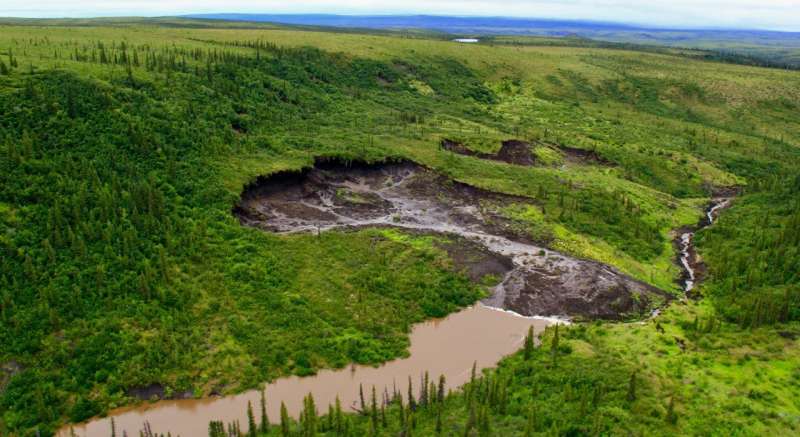Record levels of mercury released by thawing permafrost in Canadian Arctic

Permafrost thaw slumps in the western Canadian Arctic are releasing record amounts of mercury into waterways, according to new research by University of Alberta ecologists.
"We measured total mercury concentrations of up to 1,200 nanograms per litre," said Ph.D. student Kyra St. Pierre, a Vanier Scholar who co-led the study with fellow graduate students Scott Zolkos and Sarah Shakil.
Permafrost thaw slumps are the Arctic's version of landslides, made up predominantly of ice and mud.
The highest reported concentration of total mercury in studies of Canadian locations had been around 18 nanograms per litre.
"Concentrations of mercury were elevated for at least 2.8 kilometres downstream of thaw slumps," added St. Pierre. "This suggests that some mercury from thaw slumps may be transported for many kilometres through downstream ecosystems, and into larger waterways."
As climate change induces widespread permafrost thaw, the mercury stored in it becomes available for release into the surrounding environment.
"This may release a substantial amount of mercury into freshwater ecosystems across the Arctic," explained St. Pierre, who conducted the study under the supervision of Suzanne Tank and Vincent St. Louis.
Mercury is a naturally occurring contaminant that is toxic to humans and other animals in large quantities as it accumulates in organisms and food webs. Sediments in permafrost are estimated to store more mercury than Earth's oceans, atmosphere and soil combined.
Because the mercury is locked within sediments, the scientists are unsure whether the mercury could be consumed by organisms in the area and whether the mercury poses any threat to the security of northern food webs.
The results highlight the need for further research on mercury cycling in regions experiencing active permafrost thaw, as well as studies examining whether and how this mercury might enter food webs in surrounding ecosystems.
The research was conducted in partnership between the U of A and the Government of the Northwest Territories in response to N.W.T. community interests in the downstream effects of permafrost thaw.
The study, "Unprecedented Increases in Total and Methyl Mercury Concentrations Downstream of Retrogressive Thaw Slumps in the Western Canadian Arctic," was published in Environmental Science & Technology.
More information: Kyra Alexandra St. Pierre et al. Unprecedented increases in total and methyl mercury concentrations downstream of retrogressive thaw slumps in the western Canadian Arctic, Environmental Science & Technology (2018). DOI: 10.1021/acs.est.8b05348
Journal information: Environmental Science & Technology
Provided by University of Alberta



















